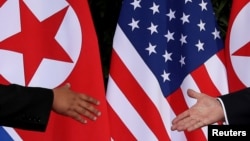President Donald Trump and North Korea leader Kim Jong Un will meet this week in Vietnam for a second summit on denuclearization. In an interview Monday with VOA News Center Deputy Managing Editor David Jones, VOA’s Korean Service Chief Dong Hyuk Lee talked about the outcome of the 2018 summit and what can be expected from the meeting in Hanoi.
Jones: Do you believe Kim Jong Un is serious about ever giving up his nuclear program? What do you think he wants in exchange?
Lee: One thing is really important here: Kim Jong Un has never promised to unilaterally denuclearize his country. What he has promised to do is the denuclearization of the Korean Peninsula. Now, the U.S. maintains that the denuclearization of the peninsula, in essence, means the denuclearization of North Korea, because there are no nuclear weapons in South Korea. From the North Korean perspective, it’s a different story. North Korea believes that the denuclearization of the Korean Peninsula requires the removal of the U.S. nuclear umbrella, which has larger implications. So, the definition of denuclearization is critical. And so far, it is unclear whether both sides have an agreement on that definition.
Jones: Do you believe the way is free for Kim to actually go ahead with this deal? Is there opposition within North Korea, within his government or military? What kind of an obstacle does that present?
Lee: Most North Korea watchers would agree there’s no clear indication that there’s a serious opposition or challenge to Kim Jong Un’s nuclear policy inside the country. Having said that, due to the nature of the regime, and it’s a system, one cannot completely rule out anything. Maybe down the road, at some point, Kim Jong Un might face some sort of a pressure, internal pressure, I’ll say, for more freedom and openness.
Jones: What has the North Korean public been told about this process? Do they understand what’s going on, and what do they expect?
Lee: Well, it’s hard to tell how well informed the North Korean public is about the situation. I will say there was no major development on the nuclear issue. In the country, the current talks with the U.S. are portrayed as Kim Jong Un’s efforts to revive the country’s economy and promote peace on the peninsula and renormalize relations with the United States.
Jones: What are the expectations and understanding among the South Korean public?
Lee: The majority of South Koreans hope that the second summit will produce some sort of substantive result. That doesn’t mean the majority of South Koreans are optimistic about the prospects for the summit. For example, there is a fair amount of skepticism. In the country, a lot of conservatives view President Moon's (Jae-in’s) policy that favors reconciliation and engagement with North Korea with deep, deep skepticism.
Jones: Trump and Kim met before in Singapore and came out with a grand pronouncement about peace. What has actually been accomplished since then?
Lee: North Korea has basically suspended the test of nuclear weapons and missiles. In Bhutan, the U.S. has suspended joint drills with South Korea. As a result, tensions between the two Koreas, and tensions between the U.S. and North Korea, have substantially deescalated. There has not been much progress on the nuclear issue.
Jones: The U.S. initially was demanding complete denuclearization on the North's side before they can be relieved from sanctions. Now, they seem to be more open to a step-by-step process. Is that correct?
Lee: What has become sort of an evolution or change from the previous position as you described is now, the U.S. Is more open to taking corresponding measures in return for North Korea’s action toward denuclearization. That’s separate from a step-by-step approach to denuclearization. I think the U.S. is still highly interested in having a big package deal in which they are open to taking corresponding measures, again, in exchange for North Korea’s action.
Jones: The North also seems interested in some kind of treaty to formally end the Korean War after all these decades. Do you think that will come up this week?
Lee: It could. I think if there is any agreement on that issue, it will be more like a bilateral one. Remember, China is one of the parties who was involved in the whole process. So, I don’t think they’ll have time to have China on board. So, if you have any agreement on that declaration, it’ll be something between the United states and North Korea.
Jones: What can we realistically expect to come out of this summit?
Lee: First, we have to think about what the key difference is between the two sides. North Korea puts high priority on normalizing relations with the United States. So, their view is, denuclearization can come as a result of normalized relations between the United States and North Korea. The United States puts a high priority on denuclearization — North Korea’s denuclearization. So, it’s vice versa. The U.S. views that normalized relations could come as a result of North Korea’s denuclearization.
So, how much both sides can bridge the gap, is a key question. North Korea has offered to dismantle its main nuclear complex in Yongbyon contingent upon unspecified corresponding measures from the U.S. side. They also proposed to dismantle its missile launch site, and possibly allow nuclear inspectors to their nuclear test site to check or confirm the status of the site.
Well, North Korea also demands possibly sanctions relief, and they’re also seeking some sort of security guarantee from the U.S. side. The U.S. is interested in possibly offering the establishment of liaison offices in both capitals.










